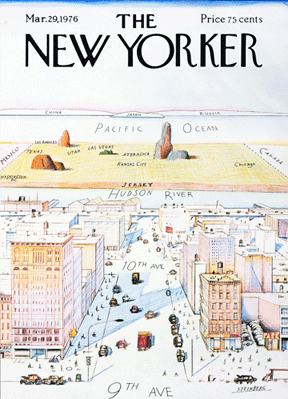
Mental Models and
Your Life Story
A mental model, at its simplest, is how you imagine
a system to be organized. The model may or may
not correspond to
“reality” but it represents how
you understand reality. It exists in your mind and
is constructed by piecing
together your experience
and perceptions into a coherent understanding of
how
they all come together. A simple
illustration
of a mental model is Saul Steinberg’s famous
cover for The New
Yorker magazine. In this
tongue-in-cheek depiction of a New York resident’s understanding of the USA, not much lies west of 10th Avenue until you get to Los Angeles. While the drawing pokes fun at those of us living east of the Hudson, it does make the good point that our mental models stress what is subjectively salient and deemphasize all else.
Another useful aspect of mental models is that they provide a latticework for old and new experiences. They are often simplified renderings of reality but summarize what we’ve learned into a shorthand that helps us generalize to new situations. A good designer will put much thought into users’ mental models. A familiar example is your computer’s operating system. The designers provide a familiar framework: a desktop complete with files, folders and trash. Your understanding of how to use your computer is largely based on this mental model that draws from your experience in the non-virtual world. Operations will be easier if they are consistent with this model because you can understand them more quickly. Alternatively, operations inconsistent with the model will be more difficult to learn and remember. Your future expectations are also based on your mental models. To rephrase a common truism: Your model of the past is a good predictor of future expectations.
Why so much about mental models? Because your internalized life story is a mental model. In constructing this model you selectively emphasized some events and deemphasized others. You chose to assign meaning to the “facts” comprising your model and actively drew connections, associations, and causal relationships between these facts. You also assigned judgments to branches of the model. Some represent positive aspects of your life and others represent what you think of as negative aspects. You took all of these events, their relationships and their interpretations and turned them into your story of you.
This model of your life is the summary you draw upon when trying to understand your life and project into your future. Perhaps in the past you saved someone from drowning or extinguished a fire before it spread. Your model may contain the summary belief “I’m someone who can be counted on in an emergency.” This branch of your model is likely to infuse you with bold confidence and help you deal with unexpected situations in the future. Undoubtedly, you also faced your share of challenges. Perhaps you didn’t gain admission to your first choice school or win that top job offer. Maybe you struck out at a crucial moment in your softball team’s championship game or were timid at moments suited for boldness or bold when timidity might have been a better approach. You have likely incorporated these facts of your life into your model, as well, along with associated beliefs. The conclusions “not good enough,” “not skilled enough,” or “not socially competent” may have become implicit branches of your model and can infuse you with corresponding limiting beliefs and projections about the future. In fact, you may have constructed a life story that makes little sense to you now or leaves you more likely to anticipate negative outcomes than positive ones because parts of the story are outdated. Using it as your life’s model would be like using The New Yorker map mentioned above to navigate from Saint Louis to San Francisco. Neither city appears on the map!
An important feature of mental models is that they are active constructs. Parts of the model can be reframed, reevaluated, tweaked, removed, added or reinterpreted. Not only can we adjust the model as we move through life and add new experiences but it is possible to reconfigure old “facts” and experiences into an updated, more meaningful model. Accepting that second choice job may have been a crucial step in leading to unanticipated opportunity that only became apparent years later. Striking out at bat might have been a great lesson in resilience. Your temperament might be better framed now as judicious sensitivity toward others. With new wisdom and enlightening perspective can come a more coherent and empowering life story.
We are frequently left with vestigial, unchallenged elements of our life story. They linger like undusted cobwebs and are expressed as limiting beliefs or as the familiar voice of our inner critic. These parts of your model can be examined, questioned and adjusted. The life story that made sense years ago probably needs updating. With a shift in perspective and some powerful questions you can examine who you are now and how congruous your life story is with your present self. A more congruous life story will lead to better decisions and more resonant choices as you make your journey. (Other Thoughts and Essays)
All content copyright Michael D. Rabin, Ph.D., LLC
